
|
Sale 33
Manuscript and Collectibles Auction
| Lot |
Photo |
Description |
Realized |
Lot 826 |
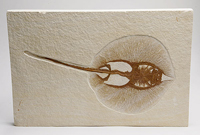 |
14" Long Stingray and Fish Fossil. Stingrays (Heliobatis radians) are among the rarest and most beautiful of all the Green River, Wyoming fossils. These rare stingrays were cut off from the inland sea as it started draining in the late Cretacious period. Stingrays are so rare in the fossil record because, just like sharks, they are mostly cartilage. This museum quality, 14" long, 50 million year old stingray is nearly complete, with details rarely seen on such fossils. The very tiny bones of the "wing," the eyes, stingers, and even the male sex organs, called claspers, are very clear. The claspers, also seen on sharks, are 1" conical-shaped organs pointing downward right above the tail. As an extra bonus, there is a 2 �" long Knightia fish above the stingray. For the collector desiring the finest quality stingray. Add $50 for domestic shipping.
Estimated Value $2,500 - 3,500.
View details and enlarged photo
| Realized
$1,725 |
Lot 827 |
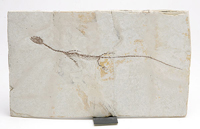 |
150 Million Year Old Aquatic Reptile From China. This new and unusual reptile, Sinohydrosaeurus lingyuanensisgen, lived in fresh water and was buried in an enormous volcanic eruption 150 million years ago in Liaoning Province, China. This nearly complete, 6 ½" long, juvenile specimen is missing only a couple of digits on one of its back feet. The delicate skull is complete, even with very small sharp teeth. All of the bones are well preserved with excellent detail usually lacking in such a small delicate fossil. The bone is a medium brown color and is nicely positioned on a 7" long by 4½" wide light soft stone matrix and housed in a 8 ½"x6 ½" Ryker Mount. Sinohydrosaurus may be related to Nothosaurs, such as Keichosaurus, or Lepidosaurus, of which the Komodo Dragon is a member. Add $15 for domestic shipping.
Estimated Value $350 - 500.
View details and enlarged photo
| Realized
$288 |
Lot 828 |
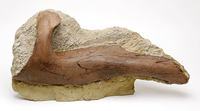 |
20" Long Lower Jaw of Duckbill Dinosaur From Wyoming. Dinosaur bones were only preserved under extraordinary conditions. The dinosaur needed to be buried relatively quickly after death for the bones to survive for millions of years. Rapid burial in water where sand and sediment would cover the bones was the most common type of preservation. Even with this condition, most of the bones of a dinosaur were washed away, leaving only isolated bones to be dug up many millions of years later.
Much of the western U.S. was covered by a large shallow sea 70 million years ago when this large Hadrosaur dinosaur, Edmontosaurus annectens, died and was swept into the shallow water. The skeleton was disarticulated and some parts were fossilized. Discovered in Niobrara County, Wyoming more than 20 years ago, this huge 20" long x 10" high lower jaw (Mandible) is virtually complete except that no teeth are visible. It is possible that some of the teeth are still buried underneath the limestone matrix. Unlike mammal jaws, dinosaurs had three bones comprising their jaw with a connecting bone at the back of the Mandible and a predentary bone in front of it. This spectacular Hadrosaur jaw still sits on its natural limestone base for display. Edmontoraurus dinosaurs traveled in herds and were a favorite dinner item of the mighty T-Rex, whose stomach contents have been found to contain Edmontosaurus bones. The bone is an attractive dark brown color and is virtually as found, with only minor repairs done to smooth out some inevitable cracks in the 70-million-year-old bone. Add $40 for domestic shipping.
Estimated Value $1,500 - 2,500.
View details and enlarged photo
| Unsold |
Lot 829 |
 |
20 Million-Year-Old Fossilized Plants and Flower From Shandong Province, China. Complete, finely detailed plant fossils are rare and flowers much rarer still. These beautiful brown and gray fossils are preserved as thin carbon layers in their pieces of diatomaceous shale. They are protected in a 12"x8" Ryker mount. This display consists of a large 1¼" flower with five petals, a 2" long flowering plant, plus a large 5¾" maple-type leaf, complete except for the left tip, and with delicate veins. A well-diversified and high-quality grouping. Add $20 for domestic shipping.
Estimated Value $200 - 400.
View details and enlarged photo
| Realized
$230 |
Lot 830 |
 |
25 Million Year Old Mammal Coprolite. Coprolites are fossilized feces and are quite rare as fossils. Fortunately, 25 million years ago in Washington state, near where Mt. St. Helens is today, volcanoes erupted burying insects, plants, and mammal coprolites. Although many coprolites have been preserved from this site, most of them are on 1" to 2" in length. Larger pieces such as this perfectly preserved 6" long specimen are rarely found. This dark brown coprolite is 6" long by 2" wide and looks exactly like what you would expect a mammal coprolite to look like, even preserving the narrow tapering at each end. Although we can't determine which mammal deposited this coprolite, we know that it was a large animal, probably a carnivore such as a bear. This desirable fossil rests on its own 4" wooden stand. Add $15 for domestic shipping.
Estimated Value $250 - 350.
View details and enlarged photo
| Realized
$180 |
Lot 831 |
 |
250 Million Year Old Colorful Red-Brown Leaves From Australia. Color doesn't fossilize, but you would not know it from this colorful collection of fossilized leaves. These leaves come from a strange kind of extinct seed fern, Glossopteris browniana known as a Pteridospermale that only grew in the Southern Hemisphere. This extremely large 20½"x13½" slab is full of many complete and partial leaves, the largest being over four inches long in various shades of rust brown to reddish brown, somewhat reminiscent of fall foliage. This most attractive and much larger specimen than usually found of this strange early tree of the late Permian Period was found in the Illawarra Coal Measure at Dunedoo, North S.W. Australia. Add $50 for domestic shipping.
Estimated Value $300 - 500.
View details and enlarged photo
| Realized
$230 |
Lot 832 |
 |
425 Million-Year-Old Family of Rare Sea Scorpions From Ukraine. This remarkable assemblage of sea scorpions contains two virtually complete specimens 5" and 3½" long, as well as parts of six other scorpions in a 7"x6" hard stone matrix. Sea scorpions were major predators in the Silurian seas 425 million years ago, with fish being armored and jawless. Also Eurypterids (sea scorpions) were probably the first animals to crawl onto land. These lovely chocolate brown fossil Eurypterids (Balteurypterus tetragonophtalmus) are found only in the Camanesk Podolski Mine in Ukraine. The smallest detail is preserved in the exoskeleton with both patterns, and even some wrinkling, as the thin outer covering fossilized. Their eyes are clearly visible, as well as their telson (stinger). Even some of the delicate walking legs are still preserved in several of the specimens. Usually only preserved as a single specimen, this grouping is most unusual and impressive. Add $25 for domestic shipping.
Estimated Value $1,000 - 1,600.
View details and enlarged photo
| Unsold |
Lot 833 |
 |
450 Million-Year-Old Trilobite With 1" Long Eyestalks. Looking like some strange kind of alien life form, this amazing 3¼" trilobite had its eyes attached to 1" long stalks that protruded above the sea floor where it buried itself to hunt for prey and to protect itself from predators. This stunning brown trilobite, Neoasaphus kowalewski, looks alive, as if it were still crawling over the creamy- smooth, textured sandstone matrix. If you could own only one trilobite, this weird specimen found near St. Petersburg, Russia, would certainly make an excellent choice. Add $20 for domestic shipping.
Estimated Value $350 - 450.
View details and enlarged photo
| Realized
$311 |
Lot 834 |
 |
50 Million Year Old Relative of the Modern Bass. Some of the most beautiful and desirable fish fossils come from the Green River area of Wyoming. Fifty million years ago there were several freshwater lakes in this area, and over a period of several million years, the lakes dried up leaving behind some magnificent fish fossils. Most of the fish from Green River are only 2 to 3 inches long but occasionally larger specimens such as this 9½" long by 5" wide relative of the modern bass named Priscacara are found and beautifully prepared. This virtually complete specimen has been carefully airbrushed to reveal even the tiniest details such as delicate fins, individual scales, many small teeth, and ten large sharp spines, the largest being over 1½" long. These distinctive spines were an excellent defense against being swallowed up by larger predators. This beautiful chocolate brown fish is on a 14"x10" cream-colored limestone slab. As an extra bonus, there is a second fish, a 3" Knightia--one of Priscacara's favorite dietary delights. Add $25 for domestic shipping.
Estimated Value $850 - 1,250.
View details and enlarged photo
| Realized
$1,035 |
Lot 835 |
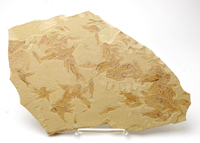 |
55 Million Year Old Minnow Mortality Plate From the Green River. The small fish Gosiutichthys parvus was an extinct member of the minnow family and was the favorite fish eaten by many other Green River fish. There are more than 60 1"-2" fish on this 12"x9" sea-bottom, stone-matrix slab. These mass mortality plates are no longer available as the quarry where they were found has been closed. Most of the small brown fish are complete with excellent detail, down to the tiny vertebrae. This is an opportunity to acquire a very interesting and different fossil fish plate rarely offered. Add $20 for domestic shipping.
Estimated Value $300 - 500.
View details and enlarged photo
| Unsold |
Lot 836 |
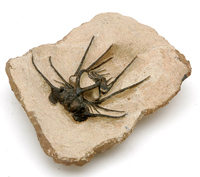 |
A Complete Spiny "Ram's Horn" Trilobite. Trilobites are an extinct arthropod most closely related to horseshoe crabs. They come in all shapes and sizes, but the most highly desired specimens are the spiny types which have sharp defensive spines to protect themselves from being swallowed whole by fish and large worms. Dicranurus is 400 million years old and was found near Alnif, Morocco. This lovely black trilobite is defined by its large curved head spines which somewhat resemble rams horns. This Dicranurus is 2.5" long by 2.7" wide, complete with curved horns and nicely contrasted against the 4"x3 ½" sand-colored matrix. Add $15 for domestic shipping.
Estimated Value $275 - 475.
View details and enlarged photo
| Realized
$431 |
Lot 837 |
 |
A Hand Claw, Foot Claw & Tooth From Deltadromeus--A Rare African Dinosaur. Most dinosaurs are known only from their teeth and a few bones. Until a few years ago, Deltadromeus was only known from its teeth and a few claws. In 1996 Paul Sereno discovered a partial skeleton in Morocco. It is now known that Deltadromeus is a coelurosaur, distantly related to T-Rex, but only about 15-20 feet long. This remarkable grouping consists of a curved 3" long middle hand claw, which is complete except for a weathered tip, a 2.9" foot claw complete with a ¼" repair to tip, and a 1" complete serrated tooth. These three rare fossils, missing from most museums, are housed in an 8 ½"x6 ½" Ryker mount. Add $15 for domestic shipping.
Estimated Value $750 - 1,350.
View details and enlarged photo
| Realized
$748 |
Lot 838 |
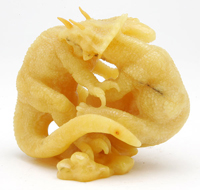 |
Amber Sculpture of A Battle Between A T-Rex and A Triceratops. This unique 3"x2¾" sculpture of a T-Rex attacking a Triceratops (actually a closely-related Anchiceratops) was commissioned from a drawing by Robert Walters. It depicts the T-Rex clawing and getting ready to bite the Triceratops while the Triceratops is defending itself by biting into the shoulder of the T-Rex with its powerful, parrot-like beak.
This spectacular display item was carved out of a single piece of brittle, honey-colored 40 million year old Baltic amber sitting on a natural flat base. The amber is a uniform and solid color due to thousands of trapped air bubbles. Being solid, rather than clear, enables even the smallest of details to be clearly observed, such as eyes, scales, claws, teeth, etc. This is a rare opportunity to own a sculpture of dinosaurs that became extinct 65 millions ago, carved from 40 million year old amber. Add $20 for domestic shipping.
Estimated Value $750 - 1,000.
View details and enlarged photo
| Realized
$805 |
Lot 839 |
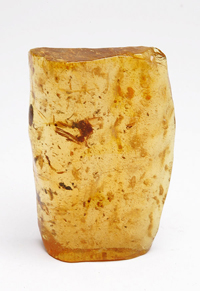 |
An Insect Zoo In Amber. This large 3"x2 ¼" piece of three to five million year old amber from Columbia contains more than 20 insects. Everything from a bee, beatles, flies, ants, fleas, larvae, etc., plus a 1½" mammal hair. This golden-colored amber has been polished on all sides to give maximum viewing. Young amber is sometimes called copal, depending on its age. Add $10 for domestic shipping.
Estimated Value $250 - 400.
View details and enlarged photo
| Realized
$264 |
Lot 840 |
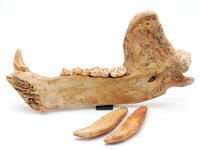 |
Cave Bear Jaw With Two Extra Incisor Teeth Complete With Roots. Ursus spelaeus was the largest bear that ever lived, only becoming extinct about 10,000 years ago. This 10½" jaw is between 20,000 and 150,000 years old and was found in a cave in Romania. The bone quality is excellent and near complete. The teeth are spectacular and colorful with shades of tan and orange contrasting with the light tan jaw bone. The large canine tooth is a full 2" in length. Also included are two additional canine teeth 3¾" in length, with their roots. The quality and eye appeal of these cave bear fossils is exquisite. Add $20 for domestic shipping.
Estimated Value $275 - 375.
View details and enlarged photo
| Realized
$228 |
Lot 841 |
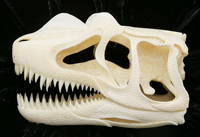 |
Ceratosaurus dinosaur Skull Carved Out of Fossilized Walrus Ivory. This spectacularly detailed dinosaur skull 3 ½"x2½" high has been carved out of fossilized walrus ivory that is between 500-8,000 years old. This fossilized walrus ivory was excavated by Eskimos on the Bering Sea coast and carved by Lee Downey, a California-born artist based in Bali, Indonesia. He is world renowned for his detailed fossil carvings. Ceratosaurus was a large, bipedal, flesh-eating dinosaur with serrated teeth. It lived 150 million years ago in the western United States and was the smaller ancestor of larger predators such as T-Rex. Its most distinguishing features, the horns above its nose and eyes are delicately carved in this spectacularly detailed carving. Also more than 60 sharp bladelike teeth are present in its open jaws giving it a fierce some look. The skull is anatomically correct with all of the holes in the skull being carefully carved and even the tiny pores in the bones have been reproduced in this magnificent, ivory-colored carving. The dinosaur skull is fitted in a black, velvet-lined Balinese cloth-covered box. Add $15 for domestic shipping.
Estimated Value $1,000 - 1,500.
View details and enlarged photo
| Unsold |
Lot 842 |
 |
Collection of Ten Amber Nuggets With 45-50 Million Year Old Insects. Baltic amber has been highly valued by humans for thousands of years, even being found in caves with the bones of early humans. Baltic amber is fossilized resin from an extinct type of coniferous tree similar to cedar and birch trees. These ten, polished, clear-amber nuggets range in size from ¼"to 1¼" each, containing one or more insects including beetles, flies, a spider, cockroach, moth, ant, etc. These classic amber nuggets were found on the Samland Peninsula of Russia and are neatly displayed in a 6"x5" Ryker mount. Add $15 for domestic shipping.
Estimated Value $500 - 700.
View details and enlarged photo
| Unsold |
Lot 843 |
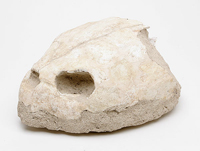 |
Extremely Large 50 Million Year Old Turtle Skull. Shark's teeth are common from the phosphate mines of Morocco, but turtles are not. This extremely large turtle skull is 9" long by 7" wide and still rests in its soft phosphate stone matrix. The lower jaw is not present but the skull is complete, uncrushed with excellent detail. With both sharks and crocodiles common in the shallow seas of Morocco 50 to 55 million years ago, to survive the sea turtles had to be both large and strong. Although no complete turtles have been found from the site, this sea turtle would have had a shell at least 5 to 6 feet in diameter. This spectacular skull was one of the largest found in a phosphate mine near Boujniba, Morocco. Add $25 for domestic shipping.
Estimated Value $450 - 650.
View details and enlarged photo
| Unsold |
Lot 844 |
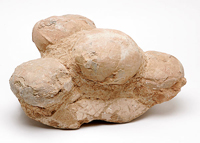 |
Five-Egg Unhatched Hadrasaur Dinosaur Egg Nest. The five eggs in this partial dinosaur nest are still in the position on the red limestone matrix where they were deposited by the mother duckbill dinosaur 70-90 million years ago in the Henan Province of China. These large eggs measure between 6-6½" in diameter and contain 30% to 50% of their original shell. However, the eggs are fully inflated maintaining their original shape with only the top egg slightly crushed. Even where the shell is missing the imprint of the shell still remains. The eggs are a medium brown color and sit on a 15"x10" brownish red matrix. These eggs still retain their original surface. Even though the exact species of dinosaur cannot be determined from their eggs. The oval shape of these eggs has been determined to be from a duckbill dinosaur. One such hadrasaur dinosaur, Shantungosaurus, has been found in the Xixia Basin of China in the same general area as these dinosaur eggs. This five egg partial nest is aesthetically positioned on its natural limestone base making a dramatic display. Add $60 for domestic shipping.
Estimated Value $1,500 - 2,500.
View details and enlarged photo
| Unsold |
Lot 845 |
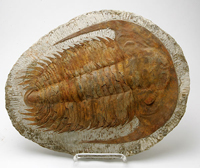 |
Giant Trilobite Paradoxites, Over 500 Million Years Old. Trilobites are an extinct group of arthropods related to the horseshoe crabs of today. Most are only an inch or two in length. Large trilobites, such as this 13"x10" giant are found only in the Atlas Mountains of Morocco. This excellent specimen is complete, from the eyes to the very small tail. It is preserved just as it died on a warm ocean bottom over 500 million years ago. It has a wonderful contrasting reddish-brown color on a light tan matrix. These impressive trilobites are in great demand by collectors, due to their huge size. Add $20 for domestic shipping.
Estimated Value $250 - 400.
View details and enlarged photo
| Realized
$288 |
Lot 846 |
 |
Great White Shark's Tooth With A Whale Vertebrae. Great White Sharks are rare today and apparently always were. The fossil record shows very few teeth have been encountered. This spectacular specimen not only has a magnificent 2" Great White tooth, but also two partial whale vertebrae that may have been lunch. It is rare to find a fossil that shows the predator-prey relationship such as this museum-quality fossil displays. About 2-5 million years ago, in Wingate Bay, California, it appears a large whale was being eaten by at least one shark. This slab measures 14"x9" with a perfect 2" Great White Shark tooth with sharp serrations, along with two partial whale vertebrae, the larger one measuring 8"x4". This remarkable fossil is from a new discovery in the Wingate Bay bone-bed of the Pismo Formation in California. Add $30 for domestic shipping.
Estimated Value $500 - 700.
View details and enlarged photo
| Unsold |
Lot 847 |
 |
Grouping of Three Different Species of 50 Million Year Old Fish. This superb grouping of nine fossil fish comes from the world-renowned Green River Formation of Wyoming. 50-53 million years ago some catastrophe occurred that quickly buried these fish in the muddy bottom of a large freshwater lake where they still look like they are swimming on the limestone matrix. This remarkable fossil contains two different species of predatory fish, along with seven smaller fish that were their prey. The largest fish is a 9" long Diplomystus dentatus and the second largest is a 7�" long Priscara dentatus, an ancient relative of the modern day Bass. Both of these large fish appear to be chasing the 3-3½" long Knightias, of which there are seven, scattered around the 33" long by 18" wide limestone matrix. These magnificent fossils have been carefully airbrushed to reveal even the most minute details such as delicate fin bones, scales, skull bones, and even the tiny sharp teeth of Diplomystus. This fossil grouping would be the highlight of most fossil fish collections and could easily be prepared for hanging in a frame. Add $100 for domestic shipping.
Estimated Value $1,500 - 2,500.
View details and enlarged photo
| Unsold |
Lot 848 |
 |
Huge 28"x25" Plaque of Over 60 Fossil Squid--475 Million Years Old. Unlike today's squid, their extinct ancestors, Orthoceras of 475 million years ago had armor in the form of a shell covering all of their body except for their tentacles and part of their head. These Cephalopods were one of the very first fierce predators of the Ordovician oceans and some grew to over ten feet long, although the average size was only 3"-6" long.
The more than 60 Orthoceras on this museum-quality slab have been carefully polished to show the inner details of their body chambers. As these squid-like animals grew, they continually added larger and larger chambers. Most fossilized Orthoceras are between 3"-6" long, but they could grow much larger as is evidenced by the gigantic 24" long specimen contained within this unusual grouping. The white fossiled squid are nicely contrasted against the black matrix. This mass-mortality plaque was found in the Sahara Desert near Rissani, Morocco. Add $85 for domestic shipping.
Estimated Value $750 - 1,250.
View details and enlarged photo
| Unsold |
Lot 849 |
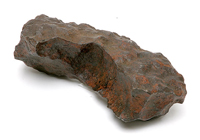 |
Iron Meteorite from Namibia, Africa. 9" long x 4" wide (at the widest part) x 2½" high. A nice, 12 pound, oblong chunk of the famous "Gibeon" meteorite. this superior, complete piece resulted from a destructive explosion that broke up this large meteor high in the atmosphere, leaving superb, thumbprint-sized dimpling of the iron skin as it melted due to the intense friction and heat. This meteor fell to earth thousands of years ago, but it was not reported to the world until 1836, when a British explorer discovered that Namibian tribesmen were using pieces of the meteorite to make spear points. Due to its high nickel content (8%), the Gibeon meteorite does not rust as severely or rapidly as do other known iron meteorites, and it displays a fine, crystalline pattern when sliced and polished. Demand for Gibeon meteorites is high because no more can be obtained from Namibia and the only available meteorites come out of collections. This is a rare opportunity to obtain a large specimen of a Gibeon meteorite. Add $25 for domestic shipping.
Estimated Value $2,750 - 3,750.
View details and enlarged photo
| Realized
$2,760 |
Lot 850 |
 |
Large 7½ Pound Patty-Type Dinoslaur Coprolite. Dinosaur excrement is highly sought after, both as a conversation piece and for study by a group of scientists called scatologists. This huge 9½" long x 6" wide x 2½" high specimen could only come from a dinosaur, since dinosaurs were the only really large animals populating the Morrison formation near Garfield, Utah 150 million years ago. This large section comes from the "Patty-Type" of coprolite, which is believed to have bee deposited by a herbivore dinosaur. The exact dinosaur can't be determined from the coprolite--only that it was a plant eater. A 1" wide section has been cut from the rough end of the coprolite and has one side polished to show the beautiful agatized creams and oranges that occurred due to the fossilization of the original organic material. The edge of the main cut section has also been polished. the resulting pattern is somewhat similar to that of fossilized wood. Add $30 for domestic shipping.
Estimated Value $200 - 350.
View details and enlarged photo
| Unsold |
Lot 851 |
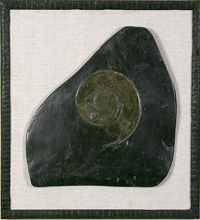 |
Large 8"x7½" Golden "Male" Ammonite From Holzmaden, Germany. Some of the most beautiful and highly-desired ammonites come from the 160-million-year-old Poseidon shale of Holzmaden, Germany. These golden ammonites have a greenish-gold color, due to being partially pyritized during the fossilization process. This constrasts nicely with the black shale matrix. This exquisite specimen is nicely centered in a 17"x16" black shale matrix and displays the gently wave-like "ribs" that added strength to the ammonite shell. also, sometimes some examples of this species, Harpoceras, have a strange, horn-like point to the end of their spiral shell. this delicate structure usually doesn't fossilize and what it was used for is not known. Since only some of these ammonites have this structure, called a Lappet, they probably belonged to only the males and were probably used somehow in mating. This special ammonite has been professionally mounted on a 21"x23" custom frame which is wired for hanging. Add $35 for domestic shipping.
Estimated Value $500 - 1,000.
View details and enlarged photo
| Realized
$546 |
Lot 852 |
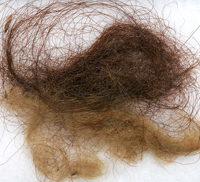 |
Large Patch of Woolly Mammoth Hair. This exceedingly rare specimen of mammoth hair consists of both types of hair present: the long, reddish-brown outer hair, as well as the soft tan inner hair. There is over then times as much hair in this lot as is normally offered. More than 30,000 years old, this remarkable specimen comes from the frozen carcass of one of only 12 Woolly Mammoths found frozen in the permafrost of the Indi-girka Basin in Siberia. This specimen was part of the collection owned by Dr. Gennady Baryshnikov, head of the History of Faunas Department, Zoological Institute, USSR Academy of Sciences in Leningrad. Add $15 for domestic shipping.
Estimated Value $500 - 800.
View details and enlarged photo
| Realized
$690 |
Lot 853 |
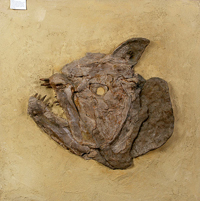 |
Massive Museum-Quality Fish Skull From One of the Largest Bony Fish That Ever Lived. The most dangerous seas of all time were certainly the Cretaceous seas that covered the middle part of the United States. These warm, shallow waters were home to many gigantic predators, such as 60-foot-long Mosasaurs, large sharks and Xiphactinus audax. At over 20 feet long, Xiphactinus audax was one of the largest bony fish that ever lived. It was a ferocious predator, with a mouth full of sharp pointed teeth up to 2" long. As a matter of fact, a Xiphactinus audax with a 6 foot fish in its stomach is one of the most famous fish fossils in the world, displayed in the Sternberg Museum of Natural History in Hays, Kansas.
The gigantic head in this lot is 23"x22"; its open jaw contains more than 20 sharp, peg-like teeth, the largest front teeth being over 2" long. This exceptionally large skull has been professionally mounted in a plaster matrix simulating limestone and custom framed with a dark brown wood frame measuring 38"x36". This magnificent 80-85 million-year-old fish fossil found in the Niobrara Chalk of Grove County, Kansas would be the highlight of any fossil fish collection. Add $350 for domestic shipping.
Estimated Value $6,000 - 10,000.
View details and enlarged photo
| Unsold |
Lot 854 |
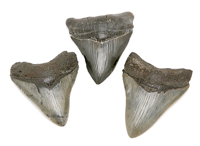 |
Matched Set of Three Large 3¾" to 4" Megalodon Shark's Teeth. These three large 3 �" to 4" 15 million year old shark's teeth (measured on the diagonal) belong to the largest shark that ever lived--Carcharocles megalodon. These teeth are almost twice as large as the largest shark alive today, the great white shark. Carcharocles was a distant cousin of the mako shark and was as large as a bus, weighing eight to ten times more than a great white shark.
These attractive black teeth are complete except for minor chipping in the upper part of the enamel that contacts the present black roots. They all possess the shark serrations that were used to slice through anything these mammoth sharks could catch. It is known from teeth marks that they ate whales. Found today in South Carolina waterways, most of the recovered teeth are broken and incomplete. Lucky for us that these huge, vicious predators are extinct. Add $20 for domestic shipping.
Estimated Value $375 - 575.
View details and enlarged photo
| Realized
$518 |
Lot 855 |
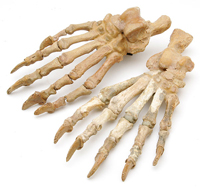 |
Pair of CaveBear Hands. Ursus spelaeus, the Cave Bear, was the largest bear that ever lived and has only been extinct for 10,000 years. These 11" long and 5" wide left and right hands are complete, down to the claws which are over 1" long and mounted with wires so that they can be easily examined. They are between 25,000-35,000 years old and were found in caves in the Bihor Mountains of Romania. The bone is a light brown in color. The size of these large, fearsome hands and sharp claws give us some idea of the ferocity of these huge cave bears which stook over 10 feet tall when they were fully grown. Add $20 for domestic shipping.
Estimated Value $600 - 900.
View details and enlarged photo
| Realized
$1,208 |
Lot 856 |
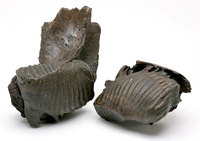 |
Pair of Complete Mammoth Teeth With Roots and Parts of Lower Jaw Still Attached. These complete, near perfect Mammoth teeth are still set in a portion of the lower jaw (one on each side). Each tooth measures 7" long x 5½" high and belonged to a juvenile Mammoth. Juvenile Mammoths only had one tooth on each side of their upper and lower jaws. As they matured, a second, smaller replacement tooth began to grow from the back of the jaw. Wooly Mammoths roamed over the northern hemisphere, becoming extinct less than 20,000 years ago. These spectacular dark brown teeth even have their roots intact and exposed in the back side of the jaw. They are over 80,000 years old, from San Fluss, Poland, a rare area for fossils. One can see even minute bone structure and enamel in the flat surfaces of these museum-quality teeth. Add $35 for domestic shipping.
Estimated Value $1,000 - 1,750.
View details and enlarged photo
| Unsold |
Lot 857 |
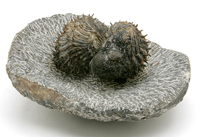 |
Pair of Giant Spiny Trilobites From Morocco. To defend itself from predators, some trilobites grew sharp spines to prevent them from being swallowed. These extremely large, over 6" long if stretched out, trilobites, Drotops armatus, have dozens of short sharp spines for defense and also roll themselves into a ball like a pill bug to protect their soft underside.
The two black trilobites centered in the 7½"x6" stone matrix show this defensive position as they are enrolled with only spines to bite, but unfortunately, they were probably buried in a mudslide over 385 million years ago. They had no defense for that kind of disaster. This magnificent display fossit was found in the Hamar Laghdad Formation of Morocco, North Africa. Add $20 for domestic shipping.
Estimated Value $850 - 1,450.
View details and enlarged photo
| Realized
$575 |
Lot 858 |
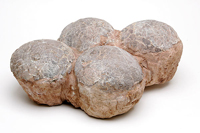 |
Partia Nests of Four Huge Dinosaur Eggs From China. All dinosaur eggs are in great demand as the supply from China has ended. Of even greater interest are the nests or partial nests. This lovely nest has four of the largest hadrosaur (Duck-billed dinosaur) eggs with a diameter of 6½"-7". There were several species of duck-billed dinosaurs living in the Henan Province of China 75-90 million years ago, as evidenced by the variety of egg sizes varying from 4"-7" in diameter. Since there were only a couple of hadrasaur species identified, some of these eggs were from species not yet discovered and identified from their bones.
The overall quality of these four eggs is excellent with70%-90% original shell still present. Also, the stone layer on the eggshell has been carefully airbrushed off revealing excellent detail on the brownish-gray eggs. One of the top eggs is missing a 3"x3" section of eggshell, but the layers of remaining shell interestingly show the shell thickness of about 2 mm. These 75-90 million year old Chinese dinosaur eggs are still partially embedded in a 16"x12" red limestone matrix. Add $60 for domestic shipping.
Estimated Value $1,500 - 2,500.
View details and enlarged photo
| Realized
$1,265 |
Lot 859 |
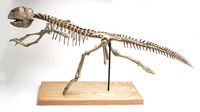 |
Dinosaur. All of the bones from this important dinosaur were removed from their 127 million year old rocky tomb and professionally mounted in a life-like running position. Most of the excellent quality bones are fused together with rods in the middle, giving the skeleton a natural appearance without wire braces or metal frames. This dramatic Psittacosaurus skeleton is 45 inches long with more than 80% real bone, unlike most museum dinosaurs which are usually cast or contain only 15 to 20% original bone. The only restored bones are the end of the tail, the neural spines, and most of the ribs. The missing bones were cast by a professional paleontologist from the finest specimen found to achieve maximum accuracy.
The all-important skull is excellent with the distinctive Jugals (extension of the jawbones) plus fenestrae (openings at the back of the skull that define Psittacosaurus as the most ancient of Ceratopsians-horned dinosaurs). Psittacosaurus did not have horns like its more famous relative, Triceratops; but in life the Jugals were covered with keratin (the same substance found in our fingernails). This keratin covering extended the length of the Jugals by several inches ending in a sharp point and giving Psittacosaurus a bizarre "warthog" type of appearance. Also, an amazing Psittacosaurus fossil was found that preserved strange long quill-like feathers on its tail. This magnificent dinosaur is so well preserved because it was buried in volcanic ash from a gigantic eruption 127 million years ago in Liaoning Province, China.
Very recently a baby Psittacosaurus was found in the stomach of the remains of a Mesozoic, dog-sized mammal, the first evidence scientists have had that some triconodont mammals were carnivorous and fed on small vertebrates, including young dinosaurs.
This rare opportunity to acquire an important museum mounted dinosaur. Psittacosaurus (which translates to parrot-beaked reptile) is scientifically very important as the smallest horned dinosaur that eventually evolved into some of the most bizarre horned dinosaurs at the end of the Cretaceous Period. The skull and all four limbs are easily removed for study and then can be put back on the Mount for a unique tabletop display. A similar specimen brought over $58,000 in a recent natural history auction.
Shipping: Allow $550 for crating and domestic shipping.
Estimated Value $15,000 - 22,000.
View details and enlarged photo
| Unsold |
Lot 860 |
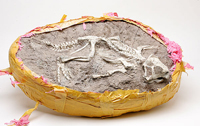 |
Psittacosaurus Dinosaur Still In Matrix. Liaoning Province, China 127 million years ago was the Pompeii for dinosaurs. A massive volcanic eruption, many dozens of times more intense than the one that destroyed Pompeii, buried everything alive at the time in this northeastern province of China. Most dinosaurs are only known from a few bones to, at best, a partial skeleton.
This remarkable 22" long juvenile Psittacosaurus dinosaur is so well preserved because of its rapid burial; it is still in the same position it was in when the eruption occurred. The bone quality is an excellent light tan color, contrasted with the red limestone matrix. The 3½"x4" skull is partially cut out of the stone, making it easier to examine. The legs and feet are very large for its size; the leg is 12" long and the foot is 3½" long. One leg shows and the second leg is probably still buried under the body. One arm is complete and the second arm is missing its hand, which might still be buried under the matrix. Even the most delicate bones are preserved in this remarkable specimen, such as the neural spines and slmost all of the thin ribs. Only a couple of vertabrae at the very end of the tail are missing completely. All of the bone present is 100% real with no restoration.
Psittacosaurus is an important dinosaur, being the oldest Ceratopsian-horned dinosaur. Psittacosaurus (translates to "parrot-beaked dinosaur) did not have horns like its most famous relative, Triceratops. It is recognized as a Ceratopsian because it possesses Jugals (extension of the jaw bones), plus fenestrae (openings at the back of the skull) that became huge frills in Triceratops. Psittacosaurus had strange quill-like feathers on its tail and was bipedal, unlike all of the later horned dinosaurs. In recent news, a baby Psittacosaur was found in the stomach of a dog-sized cretaceious mammal. This was the very first evidence of a mammal eating a dinosaur.
With China stopping the exportation of all dinosaur fossils, this is a rare opportunity to acquire a museum-quality, near-complete juvenile dinosaur. Add $500 for domestic shipping.
Estimated Value $14,000 - 25,000.
View details and enlarged photo
| Unsold |
Lot 861 |
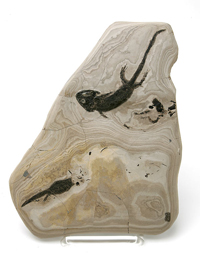 |
Rare 6" Long Fossil Amphibian Micromelerpeton From the Permian. This spectacular amphibian Micromelerpeton credneri is over 250 million years old, from Odenheim, Germany. This comes from the time before dinosaurs, when the largest land animals were the amphibians. Micromelerpeton still probably spent much of its time in water, close to the shallow sea bottom.
What makes this specimen so exceptional is its state of preservation. It is virtually complete, with the exception of a few hand and foot bones. The narrow-shaped skull is complete with even patches of its ornamented skin preserved. The body and tail is covered with carbonized skin impressions, some even preserving the texture of the skin. As a bonus, there are also two partial amphibians also present on the same 13"x8" stone slab. The 3" partial also has carbonized skin and is nearly complete, missing only its head and three legs. The two small jaws with sharp teeth are present near the top of the slab. This is a remarkably detailed and important fossil. Add $25 for domestic shipping.
Estimated Value $1,000 - 1,750.
View details and enlarged photo
| Realized
$805 |
Lot 862 |
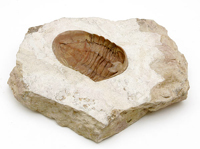 |
Rare Underside View of A Trilobite With Mouth. Trilobites were the first successful animals to acquire eyes more than 530 million years ago. They survived for more than 250 million years before becoming extinct. Their closest living relative is the horseshoe crab. Like the horseshoe crab, they had a thin shell covering all of their body on top and many legs and an exposed body underneath. Trilobites are normally found just in pieces; when a whole specimen is found, it is in the upright condition with its shell on top, as in life. This wonderful 3" trilobite, Neoasaphus punctatus, has been preserved upside down, showing its mouth parts (Hypostome), which looks like the claw of a crab, as well as its eyes, segments, shell thickening around its edges and even small nodules on the body segments where its legs attached. This spectacularly-preserved trilobite is over 450 million years old and was found near the Wolchow River of St. Petersburg, Russia. Add $20 for domestic shipping.
Estimated Value $300 - 400.
View details and enlarged photo
| Realized
$230 |
Lot 863 |
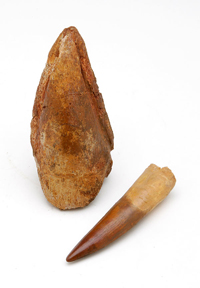 |
Set of A Foot Claw and Tooth From A Spinosaurus. Spinosaurus was the very strange, huge theropod dinosaur with a large sail on its back that was longer than a T-Rex. Spinosaurus moroccanus is known mostly from a large number of damaged, broken teeth. Dinosaur teeth are the part of a dinosaur most likely to be preserved as a fossil because of their hard enamel surface and the fact that dinosaurs constantly replaced their teeth as they fell out throughout their lives. Claws are much rarer since they were not replaced.
This lot consists of one foot claw and one tooth, both of exceptional quality. This very rare foot claw is 3 " long and is complete with only a few cracks and flaking. It is a wonderful chocolate-brown color with excellent surface details. The large 3" tooth has excellent brown enamel and even part of the root. It is smooth and superb with a complete tip that was cracked and re-attached. Both museum-quality fossils are housed in an 8"x6" Ryker mount.
Estimated Value $900 - 1,500.
View details and enlarged photo
| Realized
$863 |
Lot 864 |
 |
Spinosaurus Lower Jaw Segment With 6 Teeth + Replacement Tooth. Made famous in "Jurassic Park II," the enormous theropod dinosaur Spinosaurus, with a huge sail on its back, remains an enigmatic dinosaur, as no skeleton even remotely complete has been found. The most complete specimen (only about 20%) was destroyed during World War II. All that is available today consists of many teeth, a few claws, some vertebrae, and a very small number of jaw segments (no complete jaw exists). Thus, this 9 ½" long by 2 1/2 " wide lower jaw section with six teeth and a small replacement tooth is both an important and a dramatic fossil.
Spinosaurus was both larger and much older than T-Rex (80-100 million years old). The major difference between these two dinosaurs could be seen in their skulls and teeth. Spinosaurus' head was narrow and long like a crocodile with huge peg-like teeth, not serrated like a T-Rex. This lower jaw has six teeth ranging in size from ½" to 3" long. The largest two teeth are not broken, but the tips of the teeth have been worn down from usage. The teeth are different sizes because Spinosaurus grew new teeth when teeth were lost in feeding. Interestingly, a very tiny replacement tooth is growing in one of the sockets.
Found in the Kem Kem Valley near Taouz, Morocco (near the border with Algeria), this dramatic dinosaur jaw segment would be the highlight of any collection. Add $35 for domestic shipping.
Estimated Value $1,500 - 2,500.
View details and enlarged photo
| Realized
$1,208 |
Lot 865 |
 |
Strange Pig/Camel-Like Mammal Skull From the Badlands of South Dakota. Merycoidodon was a very strange early mammal that grew to about four feet long. It possessed some features like a pig and some like a camel or deer. The skull is somewhat pig-like but has pits in front of its eyes similar to a modern deer. The pits contain a gland that deer use to mark their territory. Merycoidodon probably used its glands similarly. This museum-quality, 3¼"x2" juvenile skull is exquisite in every respect. The bone is a lovely tan color with dark brown teeth. The teeth are complete with incisors. The skull is centered and sculpted in its natural limestone matrix. This 30 million-year-old fossil is from the Green River formation of the Badlands of South Dakota and makes an extremely impressive display. Add $15 for domestic shipping.
Estimated Value $375 - 575.
View details and enlarged photo
| Realized
$633 |
Lot 866 |
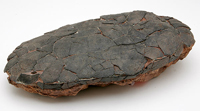 |
Tyrannosaurus Bataar Egg. A museum-quality, complete, flattened egg, 14"x6½", with nearly 100% of the original shell, cracked but intact, with beautiful dark brown color on a red limestone base. The Tyrannosaurus eggs are both the largest and rarest of all dinosaur eggs. They are so rare because Tyrannosaurs did not travel in herds like most other dinosaurs and laid their eggs in isolated nests. This beautiful egg comes from the Henan Province, China. Tyrannosaurus Bataar is a cousin of Tyrannosaurus Rex from North America; there are no known eggs from a T-Rex. Virtually all of these huge eggs are hatched and flattened and are usually found with only 30-50% of their original shell. Very rare as no more are obtainable from China. Add $50 for domestic shipping.
Estimated Value $2,750 - 3,750.
View details and enlarged photo
| Realized
$2,415 |
Lot 867 |
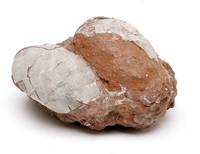 |
Unhatched Pair of Therizinosaur Eggs From China--Late Cretaceous Period. There is a real scarcity of good quality dinosaur eggs as China has stopped the export of all dinosaur eggs. Consequently, only the dinosaur eggs brought into the U.S. over the past few years are available and these have been widely dispersed to eager collectors and museums.
Therizinosaurs were the most bizarre and unusual dinosaurs. They appear to have been a plant-eating dinosaur related to veloceraptor and at least one species was feathered. Theriginosaurs walked bipedally with the body, long neck and small head of a plant-eating dinosaur, but with up to two foot long claws on their hands. What they used such arge claws for is unknown. The pair of unhatched eggs in this lot are 5" long by 3 ¼" wide. The side showing on the better of the two eggs has most of its shell intact with just a few cracks. The second egg has 50% of its shell on its top side. The shell on both eggs has been airbrushed and is a lovely light gray color on the dark brown limestone base. These Therizinosaur eggs are 65-70 million years old, from the Xixia Basin, Henan Province of China. Add $25 for domestic shipping.
Estimated Value $650 - 1,000.
View details and enlarged photo
| Realized
$546 |
|
|